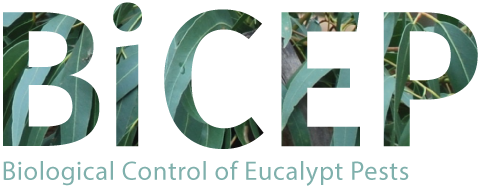Pests
Pests
Introductions of invasive Australian pests to the major eucalypt plantation growing regions of the world continue to accelerate as volumes of trade and movements of people increase. Not only the rate of introductions but also the speed of spread to new regions is expanding.
This rapid spread of insects and a general lack of basic biological data compromise efforts to coordinate and optimise biological control programs around the world. BiCEP will work to coordinate the identification, evaluation, selection, collection and shipping of natural enemies to affected regions.
Introductions of invasive Australian pests to the major eucalypt plantation growing regions of the world continue to accelerate as volumes of trade and movements of people increase. Not only the rate of introductions but also the speed of spread to new regions is expanding.
This rapid spread of insects and a general lack of basic biological data compromise efforts to coordinate and optimise biological control programs around the world. BiCEP will work to coordinate the identification, evaluation, selection, collection and shipping of natural enemies to affected regions.
-
 Glycaspis brimblecombeiThis Australian species is not considered to be a pest at home but it has become a serious pest in many countries.
Glycaspis brimblecombeiThis Australian species is not considered to be a pest at home but it has become a serious pest in many countries. -
 Gonipterus scutellatus species complexThe Eucalyptus weevils, Gonipterus spp. (Coleoptera: Curculionidae), are leaf-feeding beetles native to Australia.
Gonipterus scutellatus species complexThe Eucalyptus weevils, Gonipterus spp. (Coleoptera: Curculionidae), are leaf-feeding beetles native to Australia. -
 Leptocybe invasaThe blue gum chalcid is one of the most severe invasive eucalypt pests affecting plantation forestry worldwide.
Leptocybe invasaThe blue gum chalcid is one of the most severe invasive eucalypt pests affecting plantation forestry worldwide. -
 Ophelimus maskelliCommonly known as the Eucalyptus gall wasp, is a serious gall-inducing pest of Eucalyptus.
Ophelimus maskelliCommonly known as the Eucalyptus gall wasp, is a serious gall-inducing pest of Eucalyptus. -
 Thaumastocoris peregrinusFirst established as a pest in 2002 with the dramatic infestation of many street and garden eucalypts in Sydney, Australia.
Thaumastocoris peregrinusFirst established as a pest in 2002 with the dramatic infestation of many street and garden eucalypts in Sydney, Australia.
